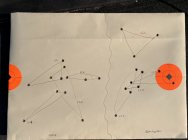Got a link that will describe in detail the method?
And as I noted above what really helps me is when people tell me *why* something works , not just that it works and then tell me to do it or then dog me for not just trusting them.

When people can tell me why it works is what persuades me. So… persuade me.

I did explain the why--all shots to the same POI at the same time eliminates groups that are good/bad due to changing conditions. That is a HUGE deal. Conditions can easily overwhelm the perfect load. I'll expound more.
When you shoot a series of groups at long range, you don't know if it the good or bad groups are from your load or the conditions. One way some get around that is to shoot LOTS of groups in varying conditions. It's easy to burn up 1/3 of the barrel life developing loads that way, at least if you really want BR quality groups. That is how I used to tune my BR rifles.
A much better way is to shoot the round-robin ladder. You load up three rounds of each charge/seating depth you want to test. You color the tips of the bullets of each different load. For example: Load 1, bare bullets, Load 2, Red bullets, Load 3 Green bullets, Load 4, Yellow bullets. You also load up some sighter rounds to make sure you are centered on paper.
When at the range you get centered on paper, then shoot your 12 test rounds. You shoot one shot from load one, one from load two, one from load three, and one from load four. Then you repeat that twice. Then you go to then target and connect the colors. Looks like this, and this isn't an exceptional ladder. I was testing brass. We use these ladders to test powder charges, seating depths, neck tension, primers, etc.

The reason we should shoot at the distance we want to compete/hunt is doing so accounts for other variables that we may not be aware of. Things like positive compensation, bullet consistency, load consistency etc. For example, the load that shoots best at 300 or 600 yds often doesn't shoot well at 1000 yds.
Now theory is fine, but the only way to know for sure is to thoroughly test it and see if it works--even if you don't completely understand the theory. When I started using the round robin tuning ladder at 1000 yds I significantly cut the amount load development rounds I needed and more importantly, my 1000 yd groups shrunk significantly.
Now when it comes to a hunting rifle, finding a load at 100 yds and then testing at longer ranges works well. My job is in fact doing that. When I find a .5 MOA 100 yd group it's no issue to be able to make center of target hits at 1100 yds. (To be honest, a .75 MOA 100 yd load would do that.) Out to 500-600 yds a drop chart works pretty, beyond that a Kestrel 5700 Elite, validates and tweaked as requires, works very well. That said, putting a couple shots within 3-4" of the center of a target is not remotely on the level of shooting LR BR winning groups and aggs.
You originally asked how to shoot better groups at long range. I told you how the shooting discipline that shoots the smallest groups at 600 and 1000 yds do it. This is not how most people find loads. Most do it like you do. Now if you don't want to try it this way no one will care, but you won't shoot as small as groups as you could.





